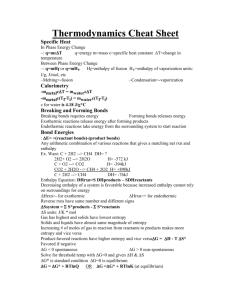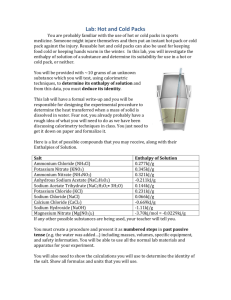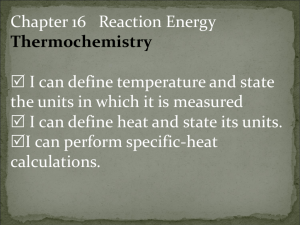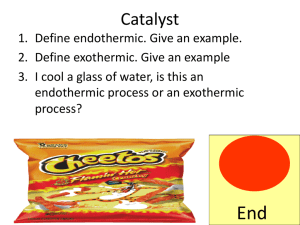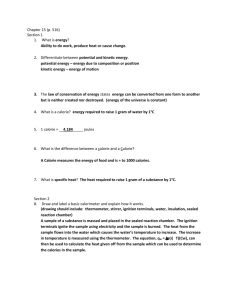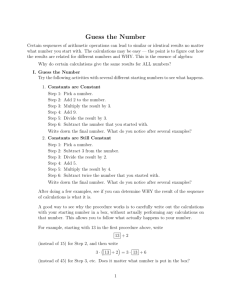Heat capacities in enthalpy and entropy
advertisement
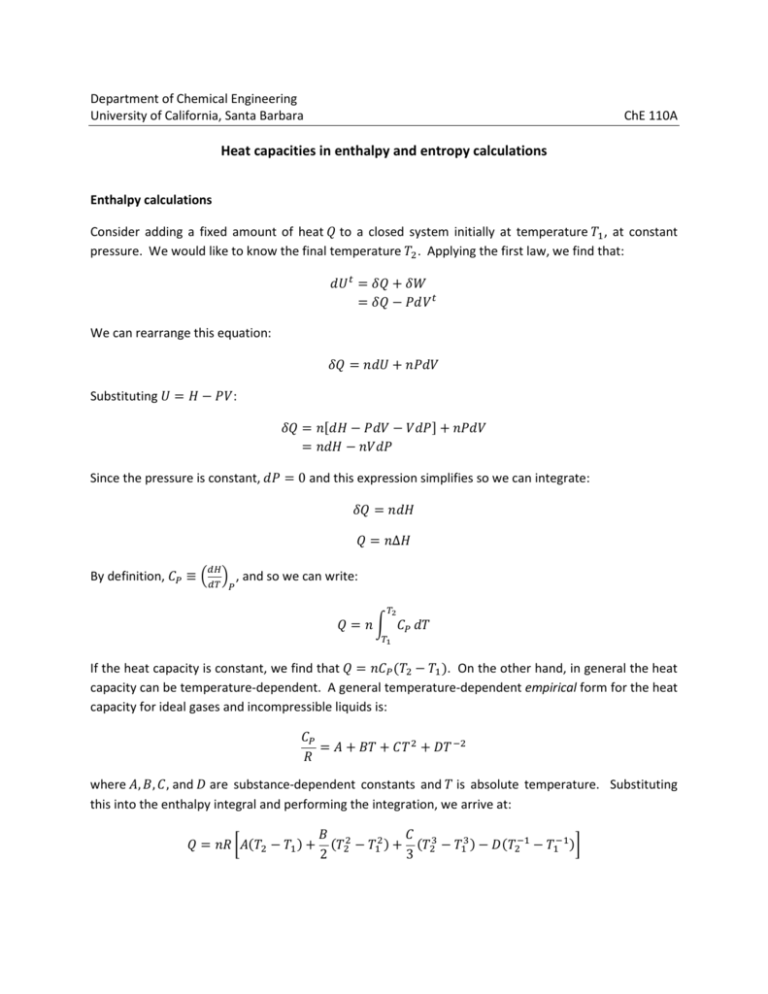
Department of Chemical Engineering University of California, Santa Barbara ChE 110A Heat capacities in enthalpy and entropy calculations Enthalpy calculations Consider adding a fixed amount of heat to a closed system initially at temperature , at constant pressure. We would like to know the final temperature . Applying the first law, we find that: We can rearrange this equation: Substituting : Since the pressure is constant, 0 and this expression simplifies so we can integrate: Δ By definition, , and so we can write: If the heat capacity is constant, we find that !. On the other hand, in general the heat capacity can be temperature-dependent. A general temperature-dependent empirical form for the heat capacity for ideal gases and incompressible liquids is: # $ % & " where #, $, , and % are substance-dependent constants and is absolute temperature. Substituting this into the enthalpy integral and performing the integration, we arrive at: " (# ! $ ! + + ! % & & !, 2 3 At this point, we could plug in the known values of everything and solve for , but we would need a fairly robust nonlinear equation solver, since there are several terms involving . A better approach would be to iterate, where we can provide a controlled initial guess. To set up the equation for iteration, we put it in the same form as the case for constant heat capacity. To do this, we multiply and divide by !: $ " -# ! 2 ! 3 + + ! % & & !. 0 1 ! ! ! where we have defined the average heat capacity 0 1 using the expression: 0 1 $ " -# ! 2 ! 3 + + ! % & & !. ! Here the subscript “H” indicates that the average heat capacity is computed with respect to enthalpy calculations. Note that 0 1 is also dependent on , the temperature for which we are solving. Thus, we need to perform an iteration. Rearranging our main equation, 0 1 To solve for , we provide an initial guess, compute 0 1 , and then compute a new value for using the equation above. We continue this process until converges. For numerical reasons, it is often more convenient to express the average heat capacity using and the ratio of the temperatures 2 / , rather than . Making the substitution 2 in the above equation, 0 1 can also be written as: 0 1 " (# $ 2 1! 2 2 1! %& 2 & , 2 3 Entropy calculations Let’s say we want to compute the entropy change in the same case as above, where the temperature of the system changes from the same to at constant pressure. Since entropy is a state function, it doesn’t matter what process we conceptualize for this change, and we will pick a reversible process as the most convenient. Starting again with the first law, simplified from the previous example: Substituting in 678 9: d 9 where we have used the definition of as before. Integrating, Δ9 If the heat capacity is constant, we arrive at: Δ9 ln < = On the other hand, if the heat capacity follows the same substance-dependent form as before, we can again substitute and integrate to get: % & Δ9 " (# ln < = $ ! ! & !, 2 2 We would like to put this expression in the same form as the constant heat capacity case: Δ9 % " -# ln ⁄ ! $ ! 2 ! 2 & & !. 0 1? ln < = ln ln < = Where we have defined a different average heat capacity 0 1? to be: 0 1? % & " -# ln ⁄ ! $ ! ! & !. 2 2 ln % 2 1 21 " @# A$ B C D < =E < =F 2 ln 2 2 C with 2 / as before. Note that the average heat capacity used in entropy calculations is different from that used for enthalpy calculations, as indicated by the subscripts “S” and “H”, respectively. Also note that, if is not specified and Δ9 is given, we would have to solve iteratively for using the rearranged expression: exp < J9 = 0 1?


